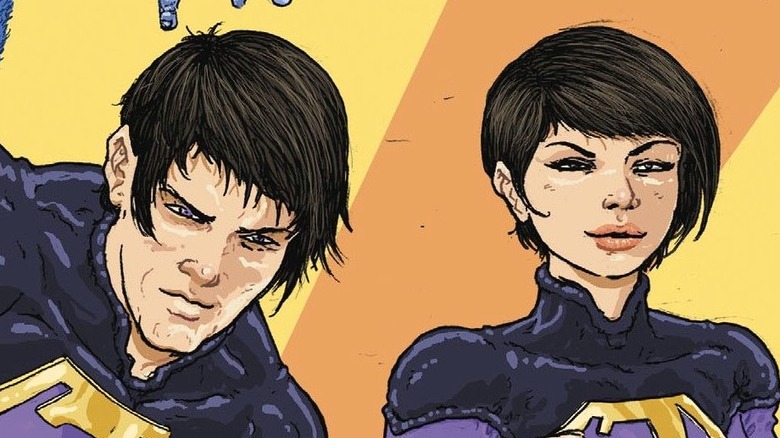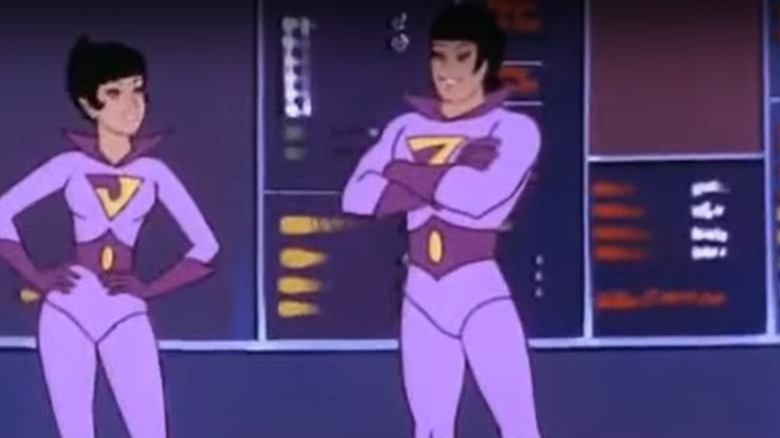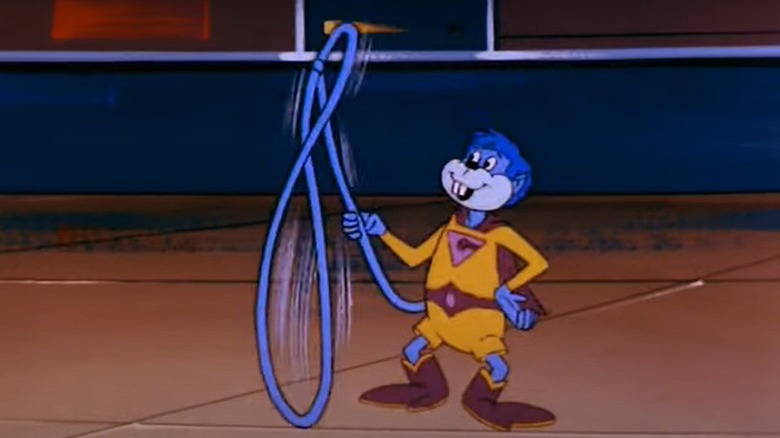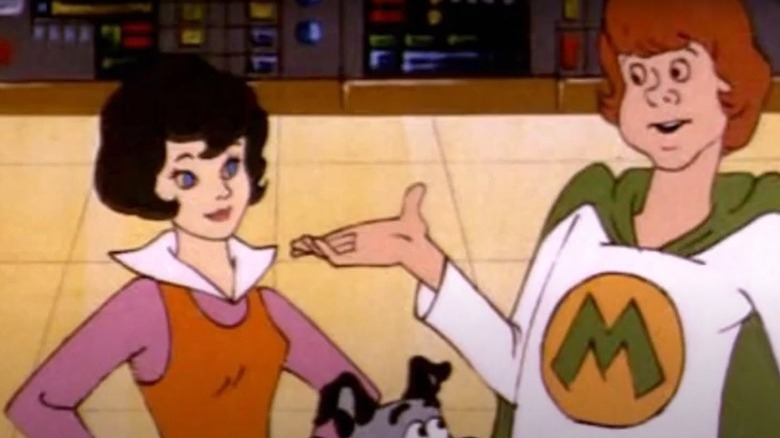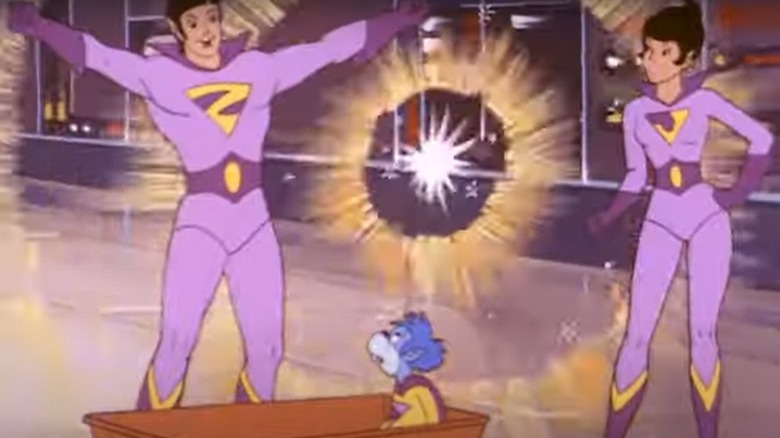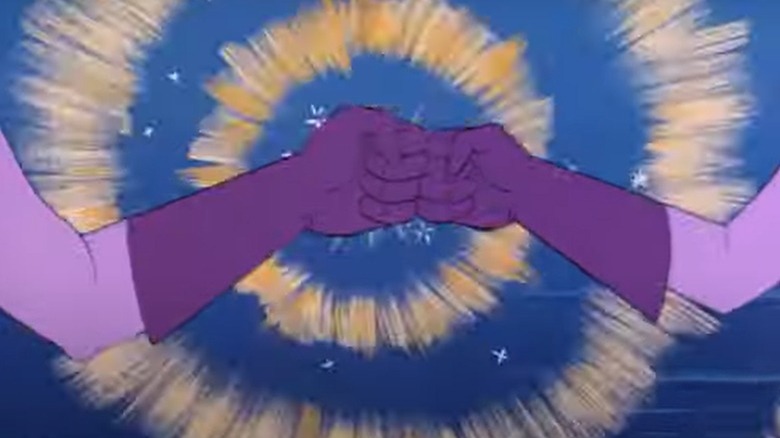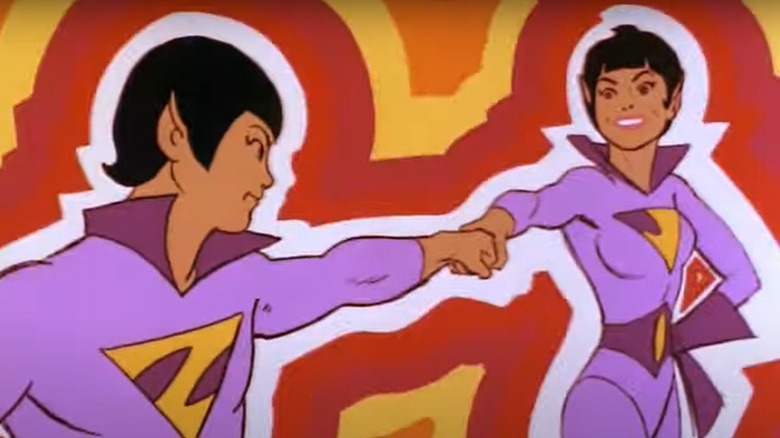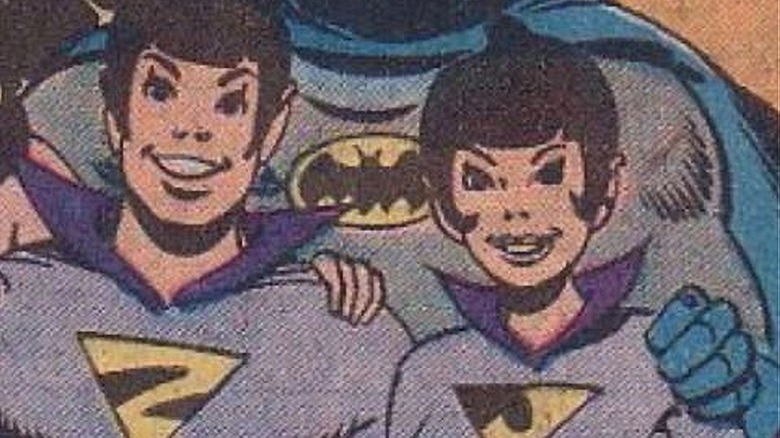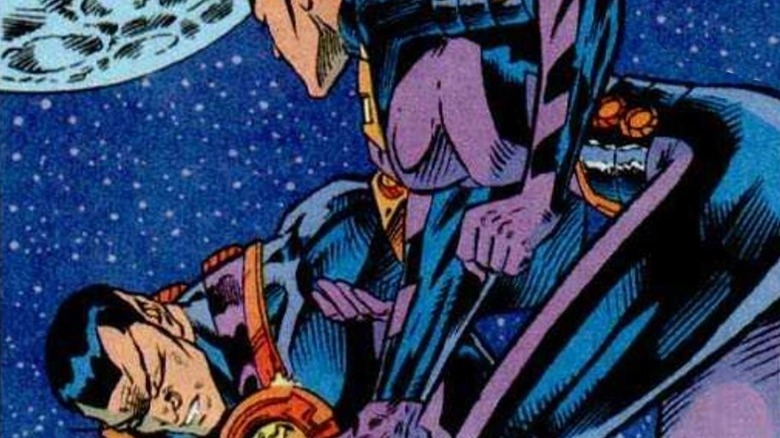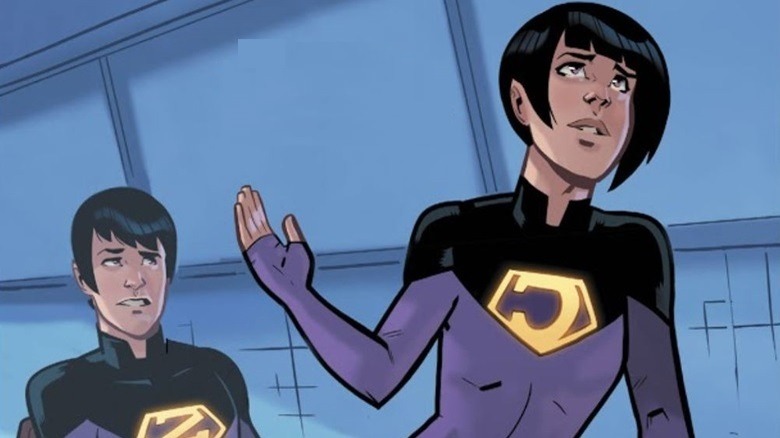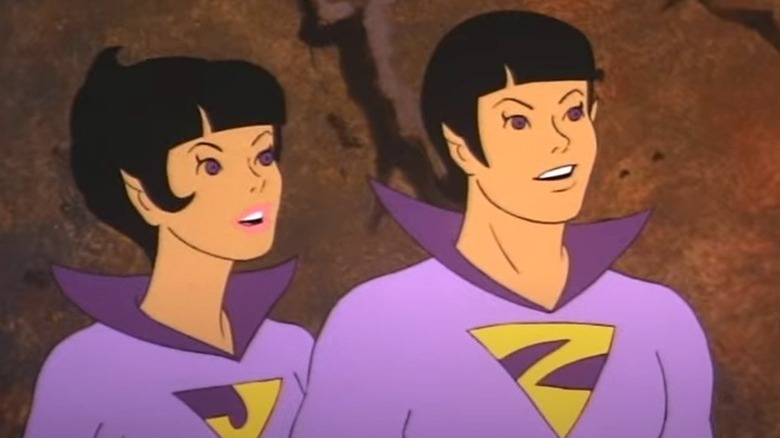The Untold Truth Of DC's Wonder Twins
Created in 1977, Zan and Jayna, the Wonder Twins, acted as mascots, a support team, and in-the-field sidekicks to the "Super Friends"-era Justice League. In the mold of the show they made their debut on, they were light, silly, and a bit disposable.
Even if you don't really care about superheroes, chances are you still have some awareness of the Wonder Twins. Much of that is due to how easy it was to laugh at the siblings. Long after their "Super Friends" heyday, Cartoon Network tapped them for between-show bumpers that mostly revolved around the heroes feeling bad about their lame powers. From there, the Twins graduated to their own set of Adult Swim webisodes that took a dark comedy approach to their portrayal. Other shows that had gags at their expense included "Harvey Birdman, Attorney at Law," "Family Guy," and "Teen Titans GO!"
At roughly the same time, however, many started to take the Wonder Twins seriously. More than 20 years after their debut, creators started including them in new comic books, trying to do new and interesting things with them. While many surely would have labeled them anachronistic holdovers from times gone by, others found excitement in the possibility of dusting them off and seeing what could be done with two twin teen aliens who just want to help. This is the untold truth of DC's Wonder Twins.
Aliens from a place no one knows
Zan and Jayna are aliens who act as superheroes-in-training and support staff with the Justice League. On "The All-New Super Friends Hour," where they debuted, this was pretty much the entirety of their story. The only other tidbit? The twins share November 6 as their day of birth. No word on if the planet where they were born on has the same 365-day a year calendar or the twins worked a complex equation to figure out which Earth day is equivalent to their birthday.
The "Super Friends" comic deepened this story a bit, explaining that the Wonder Twins aren't just aliens — they're aliens in exile who grew up in an intergalactic circus. When they finally decided to break ties with the big top, they happened to come across the villainous Grax. After overhearing the bad guy's plan to set off a series of bombs on Earth, the Twins rushed to our planet to alert the Justice League.
When their warning proved to be just in time, the League extended an offer to the duo to stay on. The exiled orphans gladly agreed, and the Wonder Twins officially became a part of the team.
Interestingly, while it's known the Twins are Exorian, whether they hail from the planet Exor or Exxor remains in doubt, as both spellings have been used over the years.
They have a pet ... a space pet
When Jayna and Zan landed on Earth, they didn't come alone: Gleek, a space monkey, came along for the ride. The Twins first encountered the monkey while in the circus, and the trio bonded quickly. When Zan and Jayna chose to run, bringing him along was a foregone conclusion.
While resembling an Earth simian fairly closely, Gleek's blue fur quickly gives him away as not of this world. And even if you manage to miss that detail, there are plenty of other signs. For one, Gleek clearly has cognitive capabilities far more like people than those of monkeys. He understands English and can communicate in sign language and pantomime.
On top of that, Gleek has superpowers. His tail is prehensile, which is admittedly not unusual for Earth monkeys, but his can also stretch — and it's strong enough to restrain and even lift a human being.
While loyal to the Twins and the League, Gleek did nearly help facilitate the utter subjugation of humankind. It turns out other space monkeys are not as heroically inclined, and a band of these conquering simians made their way to Earth. While Gleek didn't willingly help them, they were able to brainwash him into giving up the secret weaknesses of the planet's best heroes. Thankfully, he came to his senses and helped the League defeat the malevolent monkeys.
They took jobs from other people
Immediately after their first mission with the Super Friends, the Wonder Twins celebrated by stealing their predecessors' jobs.
Well, not exactly. Onscreen, the Wonder Twins arrived in 1977, ready to work. However, in the "Super Friends" comic, their jobs weren't quite available yet.
In the first incarnation of Hanna-Barbera's Justice League adaptation "Super Friends," the League had sidekicks in the form of a boy, a girl, and a pet. They were not, however, the Wonder Twins. Instead, they were two friends, Wendy and Marvin, and their talking canine Wonder Dog. While intelligent and interested in superheroics, neither of the teens had powers of their own. Despite his name and vocalizations, even Wonder Dog had no other gifts.
After "Super Friends" was canceled in 1976, Marvin and Wendy's time on television came to an end. When "The All-New Super Friends Hour" debuted a year later, they were gone, and the Twins took their place easily. On the page, though, we learned it wasn't an acrimonious transition — the human teens just more or less aged out. Ready to head to college, they no longer wished to be the League's mascots/non-powered sidekicks. Of course, they rarely left the Hall of Justice to see what the superheroes were up to, so it's hard to blame them.
Too. Much. Power
From a narrative standpoint, one of the big reasons for bringing in The Wonder Twins to replace Wendy and Marvin was so super-powered sidekicks could show up in the team's adventures, not just when the heroes were hanging around headquarters. Unfortunately, the creators' first shot at the Wonder Twins made them far too powerful.
As animator Darrell McNeil has admitted, the teens started with different abilities. For example, Zan initially had no water-related structure to his powers. Instead, he could stretch and twist his body into any form — think something more like Mr. Fantastic or Plastic Man.
Jayna started with an even more significant gap. In the beginning, she had no animal limitation to her powers. Sure, the hero could turn into an eagle or a bear. However, she could also turn into a 120-foot-tall robot or the world's deadliest missile. The only limitation was her imagination.
As a result, it seemed like the Justice League wouldn't be necessary with these two around, so the show had to scale back their abilities. Somehow that ended up with the "form of [state of water]" power that Zan has and the "shape of [any animal]" that Jayna possesses.
Sometimes when we touch
The Wonder Twins need each other, and not just because they're orphans living in a world that's not their own. No, they also need each other because without contact, their powers don't work.
Every time Zan and Jayna prepared to support the Super Friends in the field, the two went through a quick but intricate process. First, they'd need to fist-bump one another while simultaneously shouting, "Wonder Twin powers ... activate!" Then they'd both shout out their plan. "Form of a tidal wave!" and "Shape of a megalodon!" for instance.
Without the contact, neither could achieve their respective transformations. Thus, not only do they need one another for support growing up without parents and rejected by their fellow Exorians, but they need one another to fulfill their complete potential. More than any other duo, the Wonder Twins need one another to be heroes. It's a fitting metaphor for the idea that we all do better when we have at least one person we can absolutely depend on in our lives.
Animated origins
While readers and viewers met the Wonder Twins in 1977, the siblings began purely as an animated endeavor. Like Rima the Jungle Girl — also introduced in 1977 — and later additions such as El Dorado and Black Vulcan, the Wonder Twins were specifically created in-house by Hanna-Barbera to address something they felt was lacking in the "Super Friends" show. In the case of the other named characters, the intent was to add diversity to an almost entirely white cast of characters. However, with Zan and Jayna, the animators just wanted to give the team a couple of teen sidekicks who had enough powers to be used in the field as well.
Unlike Black Vulcan, who would have to wait over 20 years to appear in print, or El Dorado, who still hasn't appeared in comics, DC immediately seized upon the super-powered siblings. Approximately a month after Zan and Jayna's first appearance on "The All-New Super Friends Hour," the duo made their print debut in the seventh issue of the non-mainstream continuity DC title "Super Friends."
Delayed arrival
While the Wonder Twins did fare much better in comic book appearances than other Hanna-Barbera original "Super Friends" characters like Apache Chief and Samurai, that doesn't mean the mainstream DC Universe stood ready to meet them with open arms.
If that seems at all confusing, allow this quick explanation. Not everything DC publishes gets included in what's called "mainstream continuity," or what the company considers officially part of their characters' stories. For example, comics based on cartoons often ended up excluded. These included titles like "Super Friends" and, later, "Batman Adventures" and "Superman Adventures," both based on those characters' well-regarded '90s cartoons. It's a tradition that continues today, allowing DC to tell child and family-friendly stories with their stable of heroes without worrying how they'll affect the books aimed towards teens and adults.
For the Wonder Twins, it took 18 years to join this official continuity. The sister and brother first showed in a book called "Extreme Justice," a spinoff title from the "Justice League," in 1995 with issue #9.
The path not taken
Writer Ivan Velez Jr. did not intend the Wonder Twins' arrival to be any mere cameo. He considered himself a big fan of the siblings and wanted to do right by them. As a result, he invested effort into their appearance, reworking their origin for the more "serious" official DC continuity. Instead of the comparatively sunny "superpowered orphans coming to Earth to help out" backstory of the cartoon, Jayna and Zan instead arrived from even bleaker beginnings.
As formerly enslaved people who escaped from their cruel captor, the siblings arrive on Earth with no agenda other than escape. Unable to speak any Earth languages and unfamiliar with human customs, they attack a group of ordinary people after interpreting their behavior as hostile and reacting without further information. However, by issue's end, the Extreme Justice team and the Wonder Twins understand each other well enough that the team recognize the attack as born of confusion, not aggression. The siblings, in turn, better understand what is and is not threatening behavior on Earth.
Alas, Velez lasted only two more issues after laying that groundwork. With both installments part of a crossover, he was unable to tell more stories with the Twins. His successor, Robert L. Washington III, kept Zan and Jayne around until "Extreme Justice" ended with #18, but the siblings never received spotlight status. It would take years for them to get another shot.
In the flesh
While primarily considered a relic of "The All-New Super Friends Hour" and the related Hanna-Barbera stories that followed, the Wonder Twins acquired substantial notoriety over the decades. As a result, when "Smallville" went superhero-happy in its final seasons, even Jayna and Zan were invited to the party.
Appearing in "Idol," the eighth episode of Season 9, the Twins were played by Allison Scagliotti — arguably best known as Claudia in "Warehouse 13" — as Jayna and David Gallagher — "Seventh Heaven," voice work on the "Kingdom Hearts" video game series — as Zan. More like contemporaries of Clark Kent than sidekicks, the siblings nonetheless had a lot to learn when it came to being heroes.
While inspired by Clark's action as the Blur — his alter ego in "Smallville" — they were considerably less skilled at the work. Initially forced to stop their activities for both their safety and the safety of others, they teamed up with Clark by the episode's end. They would make another appearance in the "Smallville Season 11" comic book, but never in the series itself.
Seizing the spotlight
More than 20 years after Jayna and Zan got to have a role in mainstream continuity only for it to almost immediately end in, the siblings got another shot at the big leagues.
Initially a six-issue limited series, the new Wonder Twins comic from writer Mark Russell and artist Stephen Byrne returned the siblings to their more classic appearance and temperament instead of their darker '90s reimagining. Once again exiles instead of formerly enslaved people, the Zan and Jayna of this series spend their days attempting to fit in at high school and their after-school hours pulling Monitor Duty shifts under the direction of the Man of Steel himself, Superman.
After its initial six-issue run, DC opted to double the limited series length to a full 12, stretching it into 2020. At issue #12, the series did end, for real this time. However, unlike the fate that befell them following their "Extreme Justice" experience, the siblings have continued to make appearances in other main continuity books, including "Justice League," "Legion of Superheroes," and "Young Justice."
The silver screen beckons
The Wonder Twins have big things ahead — specifically, a very tall and wide screen to project on and/or a television surrounded by the comforts of home.
That's right. Hollywood's hunger for superheroes has finally led to Jayna and Zan's front door.
The latest "Wonder Twins" adaptation is still early in development, but it's already been revealed that Warner Bros. has brought on director Adam Sztykiel to helm the project. Sztykiel is no stranger to Warner Bros. or DC properties — he was a writer and producer on "Scoob!" the 2020 cinematic adaptation of Scooby-Doo, the sleuthing dog who stars in four-color adventures on the page published by DC Comics. Sztykiel also had a hand in writing the screenplay for the Warner Bros./DC film "Black Adam," starring Dwayne "The Rock" Johnson.
This may be a journey over four decades in the making, but going from an animated joke to the big screen isn't a bad trajectory at all. Only time will tell if the Twins end up shouting "Blockbuster film ... ACTIVATE!"
